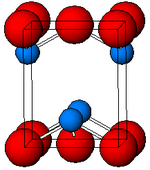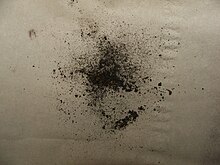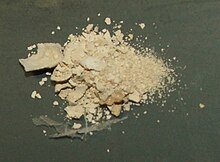Tin(II) oxide
chemical compound
Tin(II) oxide, also known as stannous oxide, is a chemical compound. Its chemical formula is SnO. It has tin in an oxidation state of +2. It also has oxide ions in it.

| |

| |

| |
| Names | |
|---|---|
| IUPAC name
Tin(II) oxide
| |
| Other names
Stannous oxide, tin monoxide
| |
| Identifiers | |
3D model (JSmol)
|
|
| ECHA InfoCard | 100.040.439 |
| EC Number |
|
PubChem CID
|
|
| RTECS number |
|
CompTox Dashboard (EPA)
|
|
| |
| Properties | |
| SnO | |
| Molar mass | 134.709 g/mol |
| Appearance | black or red powder when anhydrous, white when hydrated |
| Density | 6.45 g/cm3 |
| Melting point | 1,080 °C (1,980 °F; 1,350 K)[1] |
| insoluble | |
| −19.0·10−6 cm3/mol | |
| Structure | |
| tetragonal | |
| Thermochemistry | |
| Std enthalpy of formation ΔfH |
−285 kJ·mol−1[2] |
| Standard molar entropy S |
56 J·mol−1·K−1[2] |
| Hazards | |
| Flash point | Non-flammable |
| U.S. Permissible exposure limit (PEL) |
none |
| Related compounds | |
| Other anions | {{{value}}} |
| Other cations | {{{value}}} |
| Related {{{label}}} | {{{value}}} |
Except where otherwise noted, data are given for materials in their standard state (at 25 °C [77 °F], 100 kPa). | |
| Infobox references | |
Properties
changeIt is normally a blue-black solid. It can be red but the red form is more unstable. It burns in air with a green flame to make tin(IV) oxide. It is a reducing agent. It is rarer than tin(IV) oxide. It dissolves in acids to make a colorless solution.
Preparation
changeIt can be made by reacting sulfuric acid with tin and reacting the tin(II) sulfate made with sodium hydroxide to make the tin(II) oxide hydrate. This is heated to get the tin(II) oxide.
Uses
changeIt is used in touchscreens. It is used to make a glass with gold in it called ruby glass.
Related pages
changeReferences
change- ↑ Tin and Inorganic Tin Compounds: Concise International Chemical Assessment Document 65, (2005), World Health Organization
- ↑ 2.0 2.1 Zumdahl, Steven S. (2009). Chemical Principles 6th Ed. Houghton Mifflin Company. p. A23. ISBN 978-0-618-94690-7.